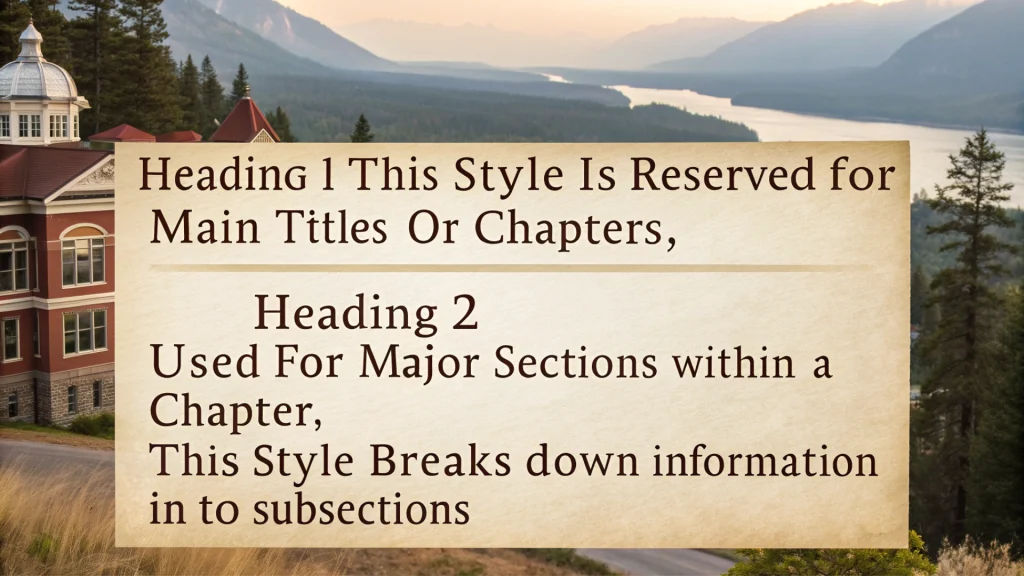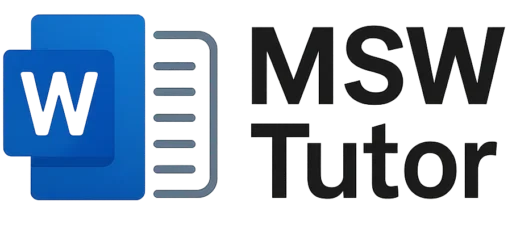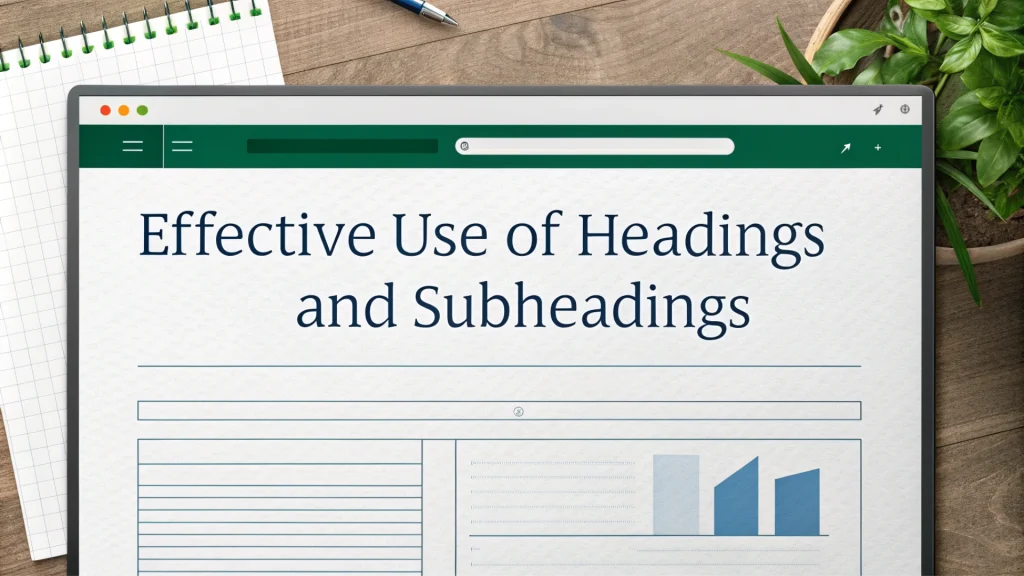Headings and subheadings in MS Word serve as a roadmap for your readers, organizing ideas and enhancing document readability. By implementing headings, you create a clear structure that guides your audience, allowing them to quickly find the information they need.
Also, headings increase the visual appeal of your documents. Applying distinct styles to headings creates an engaging layout that improves readability and enriches the user experience. Let’s explore effective strategies for using headings in MS Word to optimize your productivity!
Understanding Headings and Subheadings in MS Word
Utilizing headings and subheadings in MS Word is necessary for creating a well-organized document. They act as signposts, guiding readers through your content while boosting readability and enhancing the in general user experience. For instance, formatting a chapter title as Heading 1 highlights the beginning of a new section.
To create a clear document structure, use multiple levels of headings:
- Heading 1: Main chapter titles
- Heading 2: Subsections within chapters
- Heading 3: Further divisions as needed
The Navigation Pane makes it easy to move between sections. Simply open the Navigation Pane and click on the heading you want to access. This feature is especially useful for lengthy documents. For more help, check out these troubleshooting tips.
Plus, headings allow the automatic creation of a table of contents. This feature pulls headings directly from your document, allowing for effortless updates as you edit. Consistent use of headings keeps your content organized and easy to steer.
Mastering headings and subheadings in MS Word not only enhances text organization but also improves information retrieval and editing efficiency. With practice, you can produce documents that are both visually appealing and user-friendly.
Importance of Document Structure
Understanding the importance of document structure is necessary for effective writing. Using headings and subheadings in MS Word creates a clear roadmap for readers, boosting both readability and the in general user experience.
Headings act as signposts, guiding readers through the content. A well-organized document with a clear hierarchical structure allows users to quickly locate specific information. For instance, a defined table of contents enables swift navigation, saving valuable time. To find more about using headings for navigation, check out this resource on formatting text effectively.
Consistent formatting through styles in MS Word gives documents a polished look. This consistency is critical for maintaining content hierarchy, helping readers easily follow the flow of information. Features like outline view can remarkably improve productivity during the editing process.
A well-structured document is not just visually appealing; it also enhances accessibility for all users, including those who depend on screen readers. By prioritizing text organization, we create documents that are both informative and inclusive.
Types of Heading Styles

In Microsoft Word, different heading styles effectively organize documents, each playing a critical role in establishing a clear document structure.
- Heading 1: This style is reserved for main titles or chapters, featuring the largest font for maximum visibility.
- Heading 2: Used for major sections within a chapter, this style is slightly smaller than Heading 1 but still prominent.
- Heading 3: This style breaks down information into subsections under Heading 2, enhancing clarity.
Employing these styles creates a hierarchical organization that boosts readability and simplifies navigation. For example, a table of contents can be automatically generated based on applied headings, saving time and enhancing the user experience.
These styles are customizable to match your document’s theme. Adjust the font, size, or color by right-clicking on the style in the Styles pane and selecting Modify. This ensures all instances of that style update automatically, maintaining a together document design.
Using headings effectively also improves information retrieval. Need to find a specific section quickly?
The navigation pane lets you jump directly to any heading, enhancing productivity. For more on using the navigation pane, check out this navigation tool.
Mastering different heading styles in MS Word not only structures your documents but also enhances in general content management and accessibility. By applying these principles, you can create documents that are visually appealing and easy to steer.
Utilizing the Navigation Pane for Easy Access
The Navigation Pane in MS Word is an necessary tool for effective document management. By utilizing headings and subheadings, you can establish a clear document structure that makes finding your way lengthy texts effortless. When you apply heading styles, they automatically populate the Navigation Pane, allowing you to jump to different sections with ease, eliminating the need for endless scrolling.
To open the Navigation Pane, simply press Ctrl + F or go to the View tab and check the Navigation Pane box. This action reveals your document’s outline, helping you visualize the content hierarchy. This feature not only enhances readability but also boosts writing efficiency by streamlining content management.
- Easy Access: Jump to any section with a single click.
- Outline View: Visualize your document’s structure at a glance.
- Editing Tools: Easily reorganize sections by dragging headings.
Mastering the Navigation Pane enhances your document design and improves the user experience. This is critical for accessibility, enabling all readers, including those using screen readers, to steer your documents effortlessly.
Finding your way with Headings
Using headings and subheadings in MS Word is necessary for creating a clear document structure. This organization enhances readability and allows readers to steer your content with ease. By applying heading styles, you establish a visual hierarchy that remarkably improves user experience.
To access the Navigation Pane, press Ctrl+F or select it from the View tab. This pane displays all headings, enabling quick jumps to different sections without tedious scrolling. Think of it as a roadmap in a thick book; headings help guide readers through your document!
Formatting your headings also lets you create an automatic table of contents. This feature updates with any changes, maintaining consistency throughout your document. For more tips on enhancing your document’s efficiency, check out performance tips.
Plus, the Outline View offers a complete overview of your document’s structure, which is especially useful for lengthy reports or essays. By organizing content hierarchically, you improve information retrieval and increase in general writing efficiency.
Effectively utilizing headings and the Navigation Pane in MS Word not only enhances document design but also increases productivity. Use these tools to create well-organized and accessible documents!
Customizing the Navigation Pane
Customizing the Navigation Pane in MS Word greatly enhances document management, especially for large files. By using heading styles, you create a clear document structure that improves readability and user experience. This setup allows for swift navigation through sections, making editing and content management much simpler.
To open the Navigation Pane, press Ctrl + F or steer to the View tab and select the Navigation Pane option. Once activated, all headings are organized, offering a clear overview of your document’s flow.
You can also customize your headings’ appearance. For example, adjusting chapter titles to stand out enhances the visual hierarchy and maintains consistency throughout your document. For advanced features, check out editing tools that can further improve your productivity.
Also, the Navigation Pane allows you to create a clickable table of contents. This feature automatically updates as you revise, pulling directly from your headings. Rearranging sections is effortless; simply drag and drop headings within the pane to streamline the editing process.
Customizing the Navigation Pane is necessary for effective document editing and organization in MS Word. By applying heading styles and utilizing the pane’s features, you remarkably increase writing efficiency and in general productivity.
Enhancing Readability and User Experience
Using headings and subheadings in Microsoft Word is necessary for enhancing readability and improving the user experience. These elements create a clear document structure, guiding readers through content efficiently and ensuring a visually appealing layout.
Headings act as signposts, allowing readers to steer lengthy documents effortlessly. Well-formatted headings lower cognitive load, making it easier to find specific information. For example, the Navigation Pane in Word allows quick jumps between sections, enhancing navigation and in general efficiency.
Also, headings nurture content organization by establishing a hierarchical structure that clarifies relationships between ideas. This organization aids in information retrieval and supports automatic updates of a table of contents as you modify your document.
By mastering headings and subheadings, you can remarkably increase your productivity and improve the accessibility of your documents, making them more engaging and easier to read.
Improving Content Hierarchy
Improving content hierarchy is necessary for enhancing readability and navigation. By using headings and subheadings, we create a clear structure that helps readers quickly find information. In Microsoft Word, applying styles to these headings enables the automatic generation of a table of contents, greatly improving usability.
A hierarchical text organization reduces cognitive load and boosts the user experience. This structure not only aids in information retrieval but also enhances the visual appeal of our documents. With the navigation pane in Word, we can easily jump to different sections, increasing productivity.
To improve accessibility, prioritize text clarity and consistent formatting. Following style guides keeps our documents professional and easy to read. For more tips on effectively using headings, check out this helpful guide.
Mastering content hierarchy leads to superior document design, allowing us to communicate ideas clearly and engage our audience effectively.
Best Practices for Formatting
Using headings and subheadings in MS Word is necessary for creating clear, organized documents. They help readers quickly find key information, improving readability and user experience. Consistent styles not only make easier navigation but also reduce cognitive load, making information retrieval more efficient.
- Consistency: Use a uniform style for headings and subheadings, including font size and color.
- Hierarchy: Organize headings logically to create a clear content structure.
- Descriptive Text: Make sure headings accurately reflect the content that follows.
The navigation pane in Word allows for quick jumps between sections, especially in lengthy documents. Open it by pressing Ctrl + F or selecting the View tab and choosing Navigation Pane. For more details, check this navigation guide.
Incorporating a table of contents is another best practice. It acts as a roadmap, helping readers locate specific sections easily. Use MS Word’s built-in features to automatically generate a table based on your heading styles.
Accessibility is critical. Properly formatted headings improve document design for all users, including those using screen readers. By mastering these techniques, you can create documents that are visually appealing, easy to steer, and user-friendly.
Summing up
Headings and subheadings in MS Word increase document readability by organizing ideas and highlighting key points. Clear styles and consistent formatting create a polished, professional look. Like a map guiding travelers, headings steer readers through the text effortlessly. Using these tools enhances writing quality and enriches the user experience for everyone interacting with our documents.
Frequently Asked Questions
How can headings and subheadings improve document organization in MS Word?
Headings and subheadings structure content, guiding readers through the document and enhancing clarity and navigation in MS Word.
How to create headings in Word for navigation?
To create headings for navigation in Word, apply built-in heading styles from the Styles group on the Home tab.
How do I create a table of contents using headings in MS Word?
To create a table of contents in MS Word, apply heading styles to your sections, then go to References > Table of Contents and select a style.
What are the best practices for formatting headings and subheadings in MS Word?
Use built-in styles, maintain consistency, apply bold/italic for emphasis, and make sure clarity for easy navigation and readability.
1 thought on “Effective Use Of Headings And Subheadings In MS Word”
Comments are closed.


Pingback: How To Create Custom Word Themes & Brand Style Sets In Word? | MSW Tutor.